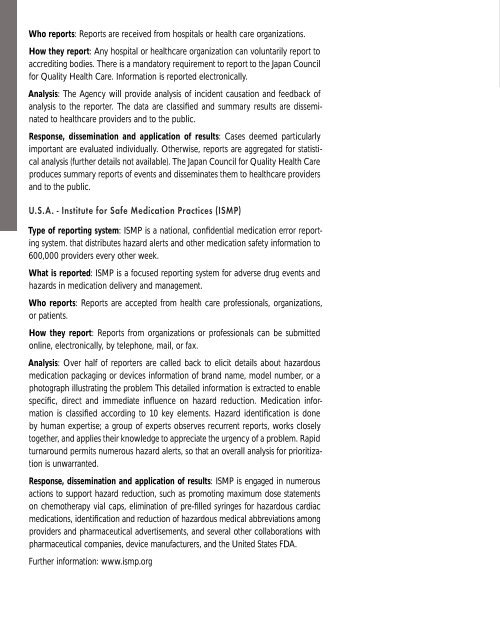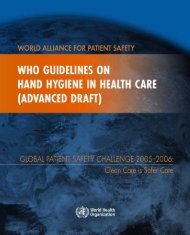Adverse event reporting.pdf
Adverse event reporting.pdf
Adverse event reporting.pdf
You also want an ePaper? Increase the reach of your titles
YUMPU automatically turns print PDFs into web optimized ePapers that Google loves.
Who reports: Reports are received from hospitals or health care organizations.<br />
How they report: Any hospital or healthcare organization can voluntarily report to<br />
accrediting bodies. There is a mandatory requirement to report to the Japan Council<br />
for Quality Health Care. Information is reported electronically.<br />
Analysis: The Agency will provide analysis of incident causation and feedback of<br />
analysis to the reporter. The data are classified and summary results are disseminated<br />
to healthcare providers and to the public.<br />
Response, dissemination and application of results: Cases deemed particularly<br />
important are evaluated individually. Otherwise, reports are aggregated for statistical<br />
analysis (further details not available). The Japan Council for Quality Health Care<br />
produces summary reports of <strong>event</strong>s and disseminates them to healthcare providers<br />
and to the public.<br />
U.S.A. - Institute for Safe Medication Practices (ISMP)<br />
Type of <strong>reporting</strong> system: ISMP is a national, confidential medication error <strong>reporting</strong><br />
system. that distributes hazard alerts and other medication safety information to<br />
600,000 providers every other week.<br />
What is reported: ISMP is a focused <strong>reporting</strong> system for adverse drug <strong>event</strong>s and<br />
hazards in medication delivery and management.<br />
Who reports: Reports are accepted from health care professionals, organizations,<br />
or patients.<br />
How they report: Reports from organizations or professionals can be submitted<br />
online, electronically, by telephone, mail, or fax.<br />
Analysis: Over half of reporters are called back to elicit details about hazardous<br />
medication packaging or devices information of brand name, model number, or a<br />
photograph illustrating the problem This detailed information is extracted to enable<br />
specific, direct and immediate influence on hazard reduction. Medication information<br />
is classified according to 10 key elements. Hazard identification is done<br />
by human expertise; a group of experts observes recurrent reports, works closely<br />
together, and applies their knowledge to appreciate the urgency of a problem. Rapid<br />
turnaround permits numerous hazard alerts, so that an overall analysis for prioritization<br />
is unwarranted.<br />
Response, dissemination and application of results: ISMP is engaged in numerous<br />
actions to support hazard reduction, such as promoting maximum dose statements<br />
on chemotherapy vial caps, elimination of pre-filled syringes for hazardous cardiac<br />
medications, identification and reduction of hazardous medical abbreviations among<br />
providers and pharmaceutical advertisements, and several other collaborations with<br />
pharmaceutical companies, device manufacturers, and the United States FDA.<br />
Further information: www.ismp.org
















